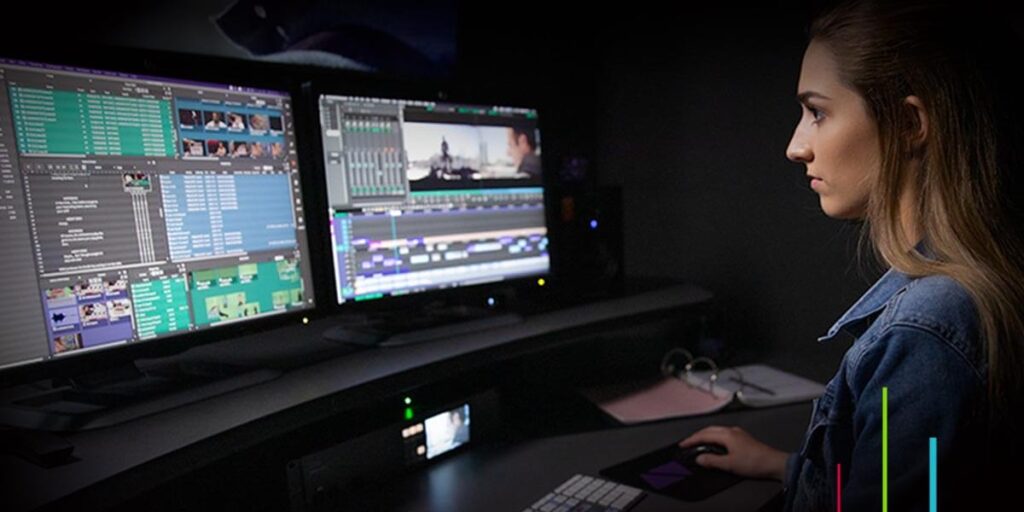Post-production is one of the three main stages of filmmaking. The process included all the necessary final steps from editing, sound engineering, VFX, foley, color grading, and trailer-making, to name a few. Post-production begins as soon as the cameras stop rolling, as it is the last step in bringing a story to the screen. The standard practice is universal across the television and film industry.
6 Crucial Steps in the Post-production Process Share on X
While these steps are an important part of completing a film, the highly collaborative process can take several months or even a year. The time consumption for post-production mostly depends on the people involved in the sound and visual departments. Read on to understand more about the post-production process and the steps it contains.

What is post-production?
Any video or movie is first raw footage that goes through a meticulous process of post-production. The art of post-production features editing the raw footage, including visual effects, adding music and sound effects, and color correcting to put together a compelling and cohesive video.
A slew of professionals from various fields such as editors, colorists, sound engineers, foley artists guarantee a smooth post-production process. It refers to all the tasks linked with refining the raw footage, assembling it, adding music, dubbing, and so on. It begins after the shooting is done, with all the footage being secured in reliable storage as the first step.
Post vs pre-production
Pre-production is the first stage involved in a film or television which comprises planning some elements of filming. It sees a comprehensive preparation process for video production such as the script, casting, location finalizing and scouting, equipment, and crew.
It organizes the steps for an obstacle-free second process, i.e. production. This stage ends when full-scale production begins.
On the other hand, post-production is the last stage of video production and begins once the planning and shooting stages are done. It involves a video editor, which takes raw footage captured during production and transforms it into a polished, engaging video through processes like organizing, cutting, and color correction.
This stage adds the finishing touches to the footage to make an engaging video before it is catered to the audience.
Why post-production is essential?
Post-production gives the final polish to a film. When production begins, raw footage is not often shot in the order intended to be presented to the audience.
The shooting happens in the most efficient way to accommodate performers, location, and other variables, which makes the post-production process an essential part of the video making process.
It is considered that the production stage is simply gathering the raw materials to be later put together into the final recipe in post-production. Without post-production, there is no final product, which makes it as crucial as pre-production or production.
6 crucial steps in the post-production workflow

To ensure a smooth workflow in post-production, a highly collaborative network undertakes different tasks. Here are six crucial steps that add the finishing touches to the video.
1. Picture Editing: The first steps of post-production, where the raw footage is put together to narrate the story. The post-production editor goes through the script, evaluates the footage, and then cuts the unnecessary parts to create an impeccable story. It also has steps from rough editing to final editing.
2. Sound Editing and Music Addition: After finalizing the footage of the film, it’s time to add and enhance the sound. Not only does it consist of adding background music, soundtrack, and sound effects, but editing out any ambient noise. The process also pieces together dialogue; if something doesn’t sound good or well-recorded, sound editors rerecord it and reinsert it in the film.
3. Inclusion of Visual Effects: Visual effects are a vital element in modern filmmaking. This step of post-production sees artists and engineers design computer-generated visual effects. Visual effects can aid filmmakers in achieving special effects that are not always feasible in life.
4. Sound Mixing: Aside from adding sound effects and music in a video, post-production executes sound mixing to adjust sound levels. This ensures that dialogs can be heard over ambient music without being too loud or garbled.
5. Color Correction/Grading: Color grading includes a color editor who goes through the movie frame by frame to fine-tune the color to maintain both mood and consistency of the story. The process includes white balance concerns, fixing exposure issues, and regulating light in every shot.
6: Trailer Making: Once all footage of the film is complete with editing, music, and VFX effects, a new team takes over to create a trailer, which is the last step in post-production. Usually a two-and-a-half-minute preview, a trailer, is meant to entice audiences to watch the movie when it premieres.
Recommended Read:
TOP 6 DIGITAL MARKETING COURSES THAT WILL PREPARE YOU FOR A SUCCESSFUL CAREER IN 2022
5 BEST SOCIAL MEDIA ANALYTICS TOOLS FOR MARKETERS IN 2022
AMAZING TRICKS TO INCREASE SUBSCRIBERS AND VIEWS ON YOUTUBE IN 2022
General FAQs
Post-production is as essential to film production as turning the camera on and hitting record. We can only create the meaning and your message at this stage of the process when we use the footage and edit them in our film production office in Newcastle to tell your story.
Preproduction is the process of gathering everything you need before actual production starts, which makes it an essential phase of the filmmaking process.
Post-production is when the footage is edited, visual effects are added, music is composed, and titles are finalized. For footage to become a film or digital media, it needs to go through a successful post-production phase. Editing is one of the most important parts of making a film, but it’s easy to overlook.




